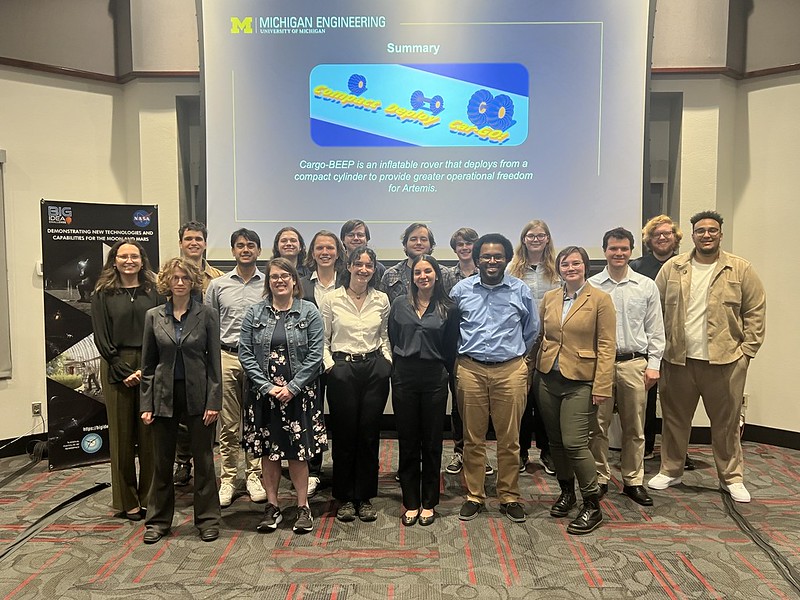
U-M Student Team Designs Lunar Cargo Robot for NASA’s BIG Idea Challenge
For the first time, an all U-M team competes in NASA challenge to benefit future Artemis missions

For the first time, an all U-M team competes in NASA challenge to benefit future Artemis missions
A University of Michigan team was one of six finalists in NASA’s 2024 Breakthrough, Innovative and Game-Changing (BIG) Idea Challenge with their idea to build an inflatable cargo balancing exploration platform for lunar exploration, similar to a segway for the moon. Over the past 8 months the group of U-M students have worked together to design and build a prototype of their own inflatable lunar vehicle and presented their design to a panel of judges in November of 2024.
Each year the BIG Idea Challenge, funded by NASA’s Space Technology Mission Directorate and Office of STEM Engagement, seeks novel ideas on new topics from universities around the country to support NASA’s Lunar Surface Innovation Initiative. The challenges work towards helping develop new approaches and innovative technologies to pave the way for exploration on the surface of the moon.
This year, the BIG Idea Challenge called for “Inflatable Systems for Lunar Operations” which asked teams to develop low Size, Weight, and Power (SWaP) inflatable technologies, structures and systems that could benefit future Artemis missions to the Moon and beyond.
The U-M team, founded by Raven St. Clair, Shai Toledano, Jason Brown, Hannah Cherry, Emma Gorbe, Christopher Packard and Michael Robinson, came up with the idea to design “Cargo-BEEP (Cargo Balancing Expandable Exploration Platform).” The design featured an expandable, two wheeled autonomous inflatable vehicle with the ability to navigate the lunar surface and assist astronauts in carrying cargo.
Their Cargo-BEEP idea would have the ability to either follow the astronaut during excursions or transport supplies between locations and was thought to be lightweight, compact and expandable, providing it the ability to be stored easily and mounted on rovers or astronauts suits while compacted.
As the team’s faculty advisor, Professor of Aerospace Engineering John Shaw commented, “They had a pretty clever idea which was to make an inflatable segway-like vehicle to help astronauts on the moon with carrying tools, samples or whatever they need.”

Once Cargo-BEEP won a finalist spot in the challenge, the team got to work and began crafting their design out of items they could easily find around them. Their first prototype featured wheels made out of pool floaties and plywood as they began work on the driving controls.
“It was difficult because the kind of layering of materials you have to do to get a wheel for the moon is a ton. All of the materials are very expensive, so to get something driving to see how it performs takes a lot,” explained Robinson. “Part of the reason the team built the physical prototype over the summer was because writing control software without the physical prototype is very time intensive, you need to set up a whole simulation environment for it. The team decided it would be more plausible to build something out of the materials we have on hand in a quick fashion, get it driving and balancing, then go from there.” Once the prototype was constructed, they took it to the Wave Field to test.
From there, the team completed the majority of their manufacturing within university facilities, helping them conserve funding. They made their inflatables out of three separate layers. The Hermetic layer being the innermost layer, provided the gas containment element of the inflatable, using polyethylene terephthalate (PET), equivalent to a thermoplastic. The second layer was a restraint layer used to contain the pressure from gas expansion along with preventing loads on the hermetic layer. The restraint layer was made by weaving together kevlar straps. An exterior abrasion layer was then fabricated to resist abrasion and other wear while driving on the lunar regolith.
At the final forum, the team presented their final report with videos of their prototype, design and controls. During the Q&A at the forum, the judges were highly interested in the materials the team used and the electronic capability of the vehicle including things like its range, its maximum weight capacity, how it moved as well as the next steps and how the team was organized. Given that the U-M team was the smallest team to complete in the finals, the judges were impressed with their ability to compile their design and prototype within the eight month timeframe.
Cherry highlighted how this project could not have been possible without the help and encouragement of faculty from the university, stating, “Our faculty advisors have been fantastic. We are beyond grateful for everything Professor Shaw did for us on this project. Professor John Shaw and Associate Professor Elliot J. Rouse from Mechanical Engineering were always very generous with their time, and able and willing to help us.”
What started as seven students, mainly from aerospace and robotics, quickly grew in size and scope throughout the project’s cycle. With a wide array of disciplines needing to be incorporated into the design and prototype – structures, materials, controls, motors and financial administration – the students quickly expanded their project team to encompass students from a wide range of majors. By the end of the project, the team grew to roughly 20 students from a variety of departments including Aerospace Engineering, Robotics, Environmental Engineering and Materials Science.
The interdisciplinary aspect of this project showcased how competitions like this bring together students from a variety of majors and backgrounds, giving them the ability to work together and discover new avenues of where their major and careers can take them. Robinson commented, “My background is social robotics, I never thought I would be building a lunar cargo robot at any point in my career or to interact with Aerospace Engineering at all, but through this project I have been working with several different teams that I never would have had a chance to work with.”